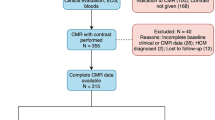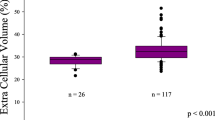Abstract
Objectives
We aimed to explore imaging features including tissue characterization and myocardial deformation in diabetic heart failure with preserved ejection fraction (HFpEF) patients by magnetic resonance imaging (MRI) and investigate its prognostic value for adverse outcomes.
Materials and methods
Patients with HFpEF who underwent cardiac MRI between January 2010 and December 2016 were enrolled. Feature-tracking (FT) analysis and myocardial fibrosis were assessed by cardiac MRI. Cox proportional regression analysis was performed to determine the association between MRI variables and primary outcomes. Primary outcomes were all-cause death or heart failure hospitalization during the follow-up period.
Results
Of the 335 enrolled patients with HFpEF, 191 had diabetes mellitus (DM) (mean age: 58.7 years ± 10.8; 137 men). During a median follow-up of 10.2 years, 91 diabetic HFpEF and 56 non-diabetic HFpEF patients experienced primary outcomes. DM was a significant predictor of worse prognosis in HFpEF. In diabetic HFpEF, the addition of conventional imaging variables (left ventricular ejection fraction, left atrial volume index, extent of late gadolinium enhancement (LGE)) and global longitudinal strain (GLS) resulted in a significant increase in the area under the receiver operating characteristic curve (from 0.693 to 0.760, p < 0.05). After adjustment for multiple clinical and imaging variables, each 1% worsening in GLS was associated with a 9.8% increased risk of adverse events (p = 0.004).
Conclusions
Diabetic HFpEF is characterized by more severely impaired strains and myocardial fibrosis, which is identified as a high-risk HFpEF phenotype. In diabetic HFpEF, comprehensive cardiac MRI provides incremental value in predicting prognosis. Particularly, MRI-FT measurement of GLS is an independent predictor of adverse outcome in diabetic HFpEF.
Clinical relevance statement
Our findings suggested that MRI-derived variables, especially global longitudinal strain, played a crucial role in risk stratification and predicting worse prognosis in diabetic heart failure with preserved ejection fraction, which could assist in identifying high-risk patients and guiding therapeutic decision-making.
Key Points
• Limited data are available on the cardiac MRI features of diabetic heart failure with preserved ejection fraction, including myocardial deformation and tissue characterization, as well as their incremental prognostic value.
• Diabetic heart failure with preserved ejection fraction patients was characterized by more impaired strains and myocardial fibrosis. Comprehensive MRI, including tissue characterization and global longitudinal strain, provided incremental value for risk prediction.
• MRI served as a valuable tool for identifying high-risk patients and guiding clinical management in diabetic heart failure with preserved ejection fraction.
Graphical abstract






Similar content being viewed by others
Abbreviations
- AUC:
-
Area under the curve
- CAD:
-
Coronary artery disease
- DM:
-
Diabetes mellitus
- FT:
-
Feature tracking
- GCS:
-
Global circumferential strain
- GLS:
-
Global longitudinal strain
- GRS:
-
Global radial strain
- HFpEF:
-
Heart failure with preserved ejection fraction
- HR:
-
Hazard ratios
- LVEF:
-
Left ventricular ejection fraction
- LVMi:
-
Left ventricular end-diastole mass index
- NT-proBNP:
-
N-terminal pro–brain natriuretic peptide
References
Paulus WJ, Tschope C (2013) A novel paradigm for heart failure with preserved ejection fraction: comorbidities drive myocardial dysfunction and remodeling through coronary microvascular endothelial inflammation. J Am Coll Cardiol 62:263–271
McHugh K, DeVore AD, Wu J et al (2019) Heart failure with preserved ejection fraction and diabetes: JACC State-of-the-Art Review. J Am Coll Cardiol 73:602–611
Ritchie RH, Abel ED (2020) Basic mechanisms of diabetic heart disease. Circ Res 126:1501–1525
Frisk M, Le C, Shen X et al (2021) Etiology-dependent impairment of diastolic cardiomyocyte calcium homeostasis in heart failure with preserved ejection fraction. J Am Coll Cardiol 77:405–419
Hulot JS, Livrozet M (2021) HFpEF: should we consider diabetic patients separately?: the cardiomyocytes say yes. J Am Coll Cardiol 77:420–422
MacDonald MR, Petrie MC, Varyani F et al (2008) Impact of diabetes on outcomes in patients with low and preserved ejection fraction heart failure: an analysis of the Candesartan in Heart failure: Assessment of Reduction in Mortality and morbidity (CHARM) programme. Eur Heart J 29:1377–1385
Kristensen SL, Mogensen UM, Jhund PS et al (2017) Clinical and echocardiographic characteristics and cardiovascular outcomes according to diabetes status in patients with heart failure and preserved ejection fraction: a report from the I-Preserve Trial (Irbesartan in Heart Failure With Preserved Ejection Fraction). Circulation 135:724–735
Aguilar D, Deswal A, Ramasubbu K, Mann DL, Bozkurt B (2010) Comparison of patients with heart failure and preserved left ventricular ejection fraction among those with versus without diabetes mellitus. Am J Cardiol 105:373–377
Lejeune S, Roy C, Slimani A et al (2021) Diabetic phenotype and prognosis of patients with heart failure and preserved ejection fraction in a real life cohort. Cardiovasc Diabetol 20:48
Gu J, Pan JA, Fan YQ, Zhang HL, Zhang JF, Wang CQ (2018) Prognostic impact of HbA1c variability on long-term outcomes in patients with heart failure and type 2 diabetes mellitus. Cardiovasc Diabetol 17:96
Seferovic PM, Petrie MC, Filippatos GS et al (2018) Type 2 diabetes mellitus and heart failure: a position statement from the Heart Failure Association of the European Society of Cardiology. Eur J Heart Fail 20:853–872
Shi K, Yang MX, Huang S et al (2021) Effect of diabetes mellitus on the development of left ventricular contractile dysfunction in women with heart failure and preserved ejection fraction. Cardiovasc Diabetol 20:185
Claus P, Omar AMS, Pedrizzetti G, Sengupta PP, Nagel E (2015) Tissue tracking technology for assessing cardiac mechanics: principles, normal values, and clinical applications. JACC Cardiovasc Imaging 8:1444–1460
Ponikowski P, Voors AA, Anker SD et al (2016) 2016 ESC Guidelines for the diagnosis and treatment of acute and chronic heart failure: the Task Force for the diagnosis and treatment of acute and chronic heart failure of the European Society of Cardiology (ESC)Developed with the special contribution of the Heart Failure Association (HFA) of the ESC. Eur Heart J 37:2129–2200
Lindman BR, Davila-Roman VG, Mann DL et al (2014) Cardiovascular phenotype in HFpEF patients with or without diabetes: a RELAX trial ancillary study. J Am Coll Cardiol 64:541–549
Gao Y, Xu HY, Guo YK et al (2021) Impact of myocardial scars on left ventricular deformation in type 2 diabetes mellitus after myocardial infarction by contrast-enhanced cardiac magnetic resonance. Cardiovasc Diabetol 20:215
Ito H, Ishida M, Makino W et al (2020) Cardiovascular magnetic resonance feature tracking for characterization of patients with heart failure with preserved ejection fraction: correlation of global longitudinal strain with invasive diastolic functional indices. J Cardiovasc Magn Reson 22:42
Romano S, Judd RM, Kim RJ et al (2018) Feature-tracking global longitudinal strain predicts death in a multicenter population of patients with ischemic and nonischemic dilated cardiomyopathy incremental to ejection fraction and late gadolinium enhancement. JACC Cardiovasc Imaging 11:1419–1429
Li S, Wang Y, Yang W et al (2022) Cardiac MRI risk stratification for dilated cardiomyopathy with left ventricular ejection fraction of 35% or higher. Radiology. https://doi.org/10.1148/radiol.213059:213059
He J, Sirajuddin A, Li S et al (2021) Heart failure with preserved ejection fraction in hypertension patients: a myocardial MR strain study. J Magn Reson Imaging 53:527–539
Kammerlander AA, Dona C, Nitsche C et al (2020) Feature tracking of global longitudinal strain by using cardiovascular MRI improves risk stratification in heart failure with preserved ejection fraction. Radiology 296:290–298
Pu C, Fei J, Lv S et al (2021) Global circumferential strain by cardiac magnetic resonance tissue tracking associated with ventricular arrhythmias in hypertrophic cardiomyopathy patients. Front Cardiovasc Med 8:670361
Romano S, Judd RM, Kim RJ et al (2020) Feature-tracking global longitudinal strain predicts mortality in patients with preserved ejection fraction: a multicenter study. JACC Cardiovasc Imaging 13:940–947
Jackson AM, Rorth R, Liu J et al (2021) Diabetes and pre-diabetes in patients with heart failure and preserved ejection fraction. Eur J Heart Fail. https://doi.org/10.1002/ejhf.2403
Funding
This study was funded by the National Natural Science Foundation of China (Grants 81971588), the Construction Research Project of Key Laboratory of the Chinese Academy of Medical Sciences (2019PT310025), the Youth Key Program of High-level Hospital Clinical Research (2022-GSP-QZ-5), Beijing Natural Science Foundation (7242110) and the National Foreign Expert Talent Project (G2021194020L).
Author information
Authors and Affiliations
Corresponding author
Ethics declarations
Guarantor
The scientific guarantor of this publication is Minjie Lu.
Conflict of interest
The authors of this manuscript declare no relationships with any companies whose products or services may be related to the subject matter of the article.
Statistics and biometry
No complex statistical methods were necessary for this paper.
Informed consent
Only if the study is on human subjects:
Written informed consent was waived by the Institutional Review Board.
Ethical approval
Institutional Review Board approval was obtained.
Study subjects or cohorts overlap
No study subjects or cohorts have been previously reported.
Methodology
• retrospective
• prognostic study
• performed at one institution
Additional information
Publisher's note
Springer Nature remains neutral with regard to jurisdictional claims in published maps and institutional affiliations.
Wenjing Yang and Leyi Zhu are the co-first author of this work.
Supplementary information
Below is the link to the electronic supplementary material.
Rights and permissions
Springer Nature or its licensor (e.g. a society or other partner) holds exclusive rights to this article under a publishing agreement with the author(s) or other rightsholder(s); author self-archiving of the accepted manuscript version of this article is solely governed by the terms of such publishing agreement and applicable law.
About this article
Cite this article
Yang, W., Zhu, L., He, J. et al. Long-term outcomes prediction in diabetic heart failure with preserved ejection fraction by cardiac MRI. Eur Radiol (2024). https://doi.org/10.1007/s00330-024-10658-y
Received:
Revised:
Accepted:
Published:
DOI: https://doi.org/10.1007/s00330-024-10658-y




